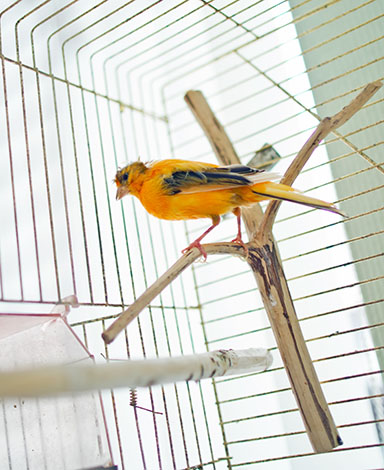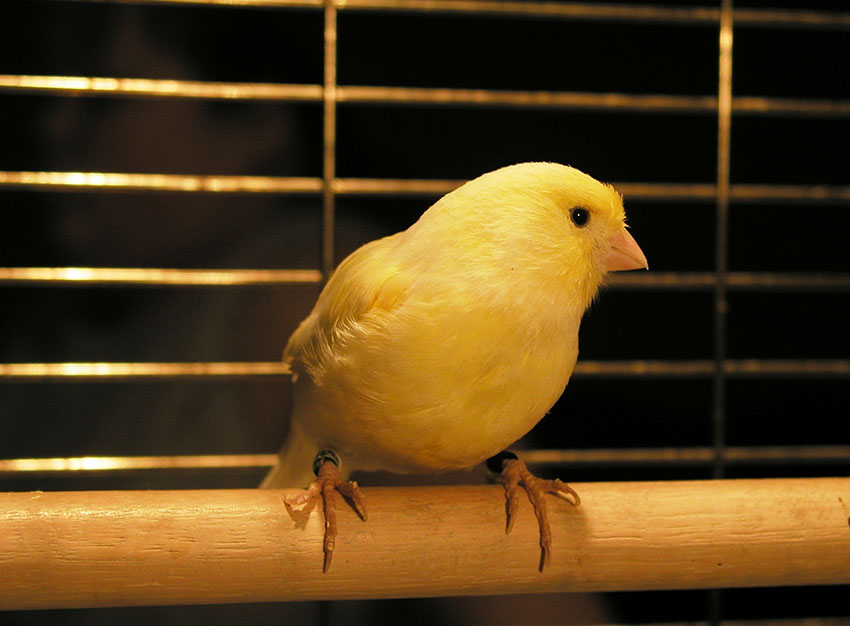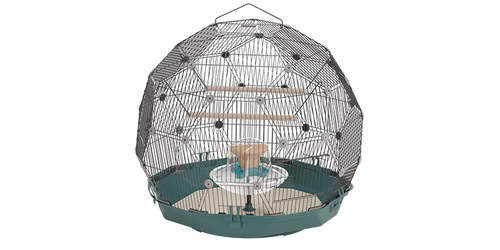If you buy a cage from a reputable seller, you're pretty much in safe waters. If you do happen to be buying a cage from a slightly less reputable source, such as from a secondhand seller or an online auction route, be sure to ask questions about potential health hazards - nothing wooden in the cage should be varnished or chemically treated, and the paint used to coat the bars has to be non-toxic. There should be no rust on the bars either.

A suitable cage is the root of all happiness for your feathered friends
All cages should come with a bottom tray, this is where the sawdust or paper is placed. This bottom section will need cleaning at least once a week. Some designs may have a removable grille which is placed above this bottom tray, this stops the birds from walking through the soiled material at the bottom, though if you keep the cage clean this shouldn’t be a problem.
A finch cage needs to be equipped with all the day-to-day essentials. These include perches, food and water bowls, some bird toys (mirrors with bells are a good choice), a bird bath and something to line the base of your cage.
Positioning a Bird CageThe positioning of your cage is much more important than you may think. A cage should always be placed at eye level, natural survival instincts cause finches to get panicky when they see something moving overhead. In the wild, any non-finch shape moving above the could be a potential predator. If your cage is placed against a wall, with minimal overhead movement, you can place it at chest level.
On the other hand, if you place your cage up too high or in a lonely spot with little human movement, your birds won’t be able to get used to the human presence and will never properly settle into your home. Noise and movement are needed outside the cage, as this help prevents boredom. If you keep your finches in a place where no one ever sees them, it raises the question - why did you get the birds in the first place”?
A sturdy and secure piece of furniture will make for a suitable surface for your cage to rest on. Sideboards or perhaps a wide shelf are a good option. Many owners choose to go for a custom made perch-stand, these can come in the form of plinths, or even stands with hooks to secure the cage.At the end of the day it doesn’t matter which cage placing method you choose, you just have to be sure that the cage is secure. It needs to be away from any areas where it could get knocked or scraped up against (by children, dogs or vacuum cleaners, juts to give an example).
One side of the cage should be against, or at least facing, a wall. Finches will retreat to this area by the wall if they are feeling in any way nervous or stressed. Putting the cage on a windowsill is not a good idea, constant sunlight through glass can actually kill pet finches, if they have no shade to retreat to. There is also a possibility of your birds catching a chill from the draft if you do opt to place them by your window.

Like all animals, Canaries' activity is regulated by light
Covering Canary Cages
Canaries’, and other pet finches’, hormones are regulated by light. They need darkness to sleep and will need to experience proper daylight throughout the day. Finches kept in a room that is perpetually half-illuminated will not fare too well. Lack of a proper day/night cycle can interfere with your bird’s hormonal balance, leading to stress, out-of-season moulting, or other “unbalanced” behaviour.
The best place to keep your cage is in a room where natural light can do its thing. If you have no such room in your house, don’t worry, you can simulate the night/day cycle by covering their cages shortly after sundown and uncovering them shortly after sunrise. This will keep your bird’s hormones at a steady level, meaning that they’ll experience normal moulting, singing and mating all at the correct time of year.
The disadvantage to the whole “covering the cage” system is the fact that in summer the sun can rise very early, forcing you out of bed just to uncover the birds, or in winter the sun may rise after you’ve already left for work. The plan will need some adaptation to combat this, though as long as you uncover the birds in the morning you should be fine.



Comments
There are no comments just yet